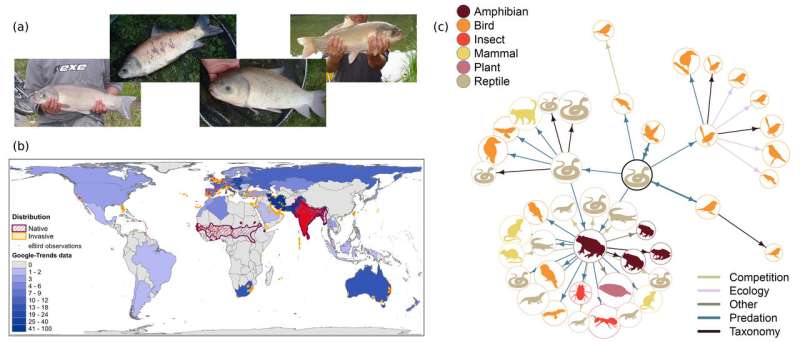Tracking species invasions with digital biodiversity data

Large online data sources are increasingly important to understand biological invasions. Emerging fields of conservation culturomics and iEcology have a great potential to inform invasion science and practice through novel insights and knowledge. In a recent publication, an international research team led by the Biology Centre of the Czech Academy of Sciences is looking at the state of the art of invasion culturomics and iEcology, and their potential applications for research and management of invasive alien species.
Invasive alien species are a major threat to global biodiversity and can have substantial socioeconomic costs. However, their monitoring and management are often inadequate, and threat of biological invasions is often underestimated by the public, with frequent opposition to their management. "There is a need to better understand societal awareness, perceptions, values and attitudes toward IAS and the level of societal support for management plans, but such research is difficult to implement," explains Céline Bellard, researcher at the University Paris-Saclay, co-author of the study.
According to a paper published in the journal Conservation Biology, great promise to tackle these issues lies in the emerging fields of culturomics and iEcology. Whereas both fields are based on the analysis of online data resources, conservation culturomics () focuses on the study of human-nature interactions, while iEcology () is focused on studies of ecological patterns and processes.
"Their major applications related to biological invasions include gauging societal awareness and effects of information dissemination and management, studying societal attitudes toward invasive species and their management, taxonomic identification and early warning of new introductions, mapping and monitoring their distribution, spread and impacts, and studying their life history, phenology, and novel biotic interactions," explains Uri Roll from the Ben-Gurion University of the Negev, another author of the study. Some of the key data sources include indices of internet search activity, data from social media, digital media such as images and videos posted online, and various geotagged online data.

Digital data and culturomic methods are becoming increasingly user-friendly, which will facilitate their uptake by the larger scientific community. "Such developments will greatly increase the volume of available information on invasive alien species, especially once web crawlers start being used more commonly, for example, to automatically scrape the web, identify and validate species' mentions, and flag range expansions," says Andrea Soriano-Redondo, from CIBIO/InBio in Portugal, another author of the study.
These data are also expected to open many avenues for novel research on invasion management campaigns and societal interactions with invasive alien species, at scales previously unfathomable. "Considering the global spread of invasive alien species and their increasing impacts, it is critical to devise new research approaches and tools. We believe that invasion culturomics and iEcology represent promising options to track and study biological invasions, as well as societal attitudes and interactions with invasive alien species," says Ivan Jarić, lead author of the study and researcher at the Biology Centre of the Czech Academy of Sciences.
More information: Ivan Jarić et al. Invasion Culturomics and iEcology, Conservation Biology (2021).
Journal information: Conservation Biology
Provided by Biology Centre of the Czech Academy of Sciences




















